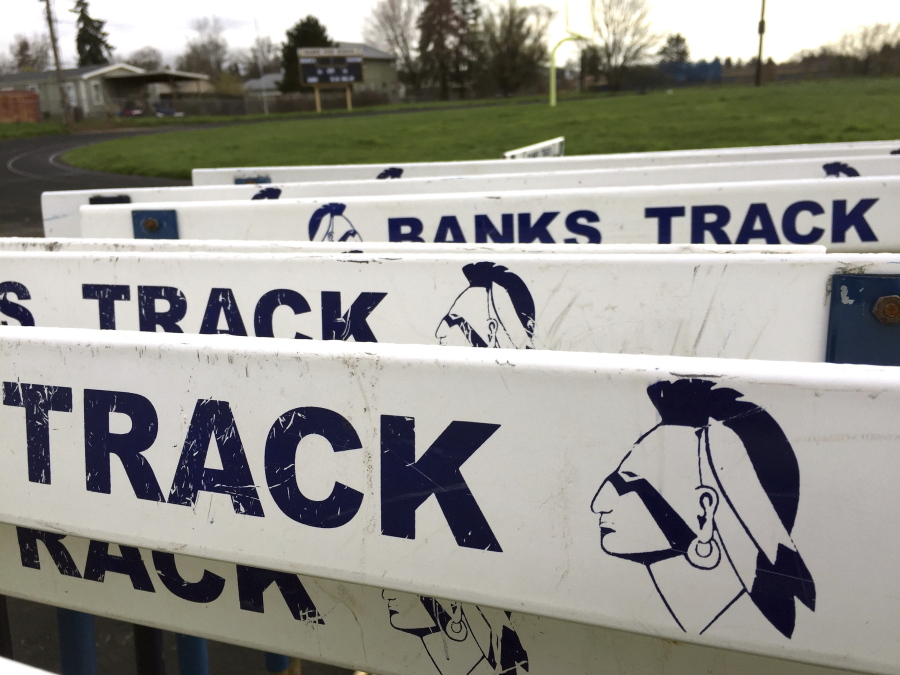BANKS, Ore. — This fall, the football team in the tiny Oregon logging town of Banks will once again take the field as the Braves. But this time, they have the approval of the tribe that originally inhabited the area.
It’s one of many changes in the works this spring across Oregon prompted by the nation’s long-running uproar over Native American sports mascots. School districts in the state with tribal mascots must do away with them by July 1 or risk punishment that could include the withholding of state funds.
However, the state will make exceptions for districts that get the approval of one of Oregon’s nine tribes — and the Banks School District is one of more than a half-dozen tiny districts trying to take advantage of that provision.
The state Board of Education voted unanimously on Thursday to approve an agreement between the Banks district and the Confederated Tribes of the Grand Ronde, the first such deal to reach the board.
The current deal, nearly two years in the making, allows the district to keep the name Braves. In exchange, it gives up the “Indian head” image — a Native American man with a partially shaved head, face paint, ear hoop and feathers — and implements a curriculum developed by the Grand Ronde that teaches the history of its people from a tribal perspective.
The process highlights the dilemma facing small schools across the U.S. as attention has focused on high-profile battles over mascots such as the Washington Redskins.
Minnesota and Wisconsin have banned Native American mascots at school districts for decades, but elsewhere communities have wrestled with the issue for years, said Jennifer Guiliano, a history professor at Indiana University-Purdue University Indianapolis.
Oregon’s statewide approach is unique, and its willingness to allow an exception for districts that collaborate with tribes calls to mind the NCAA’s long-standing ban on Native American mascots that don’t have tribal buy-in, she said.
But even with collaboration, agreements at the high school and college levels can raise questions about the nature of the long-term relationship once a deal is inked, she said.
State education officials initially did not want to allow any exceptions to the mascot ban but eventually bowed to pressure from lawmakers last year. At the time, some tribal rights groups were angry at the weakening of the policy that had been one of the toughest in the nation.
“You can have curriculum without exploiting and dehumanizing Native American people,” said Sam Sachs, founder of No Hate Zone, a racial rights advocacy website. “I think it’s great they’re having these conversations, but we only got here because there was a threat of taking away their discriminatory, race-based mascots.”
The exemption has prompted a state lawmaker to introduce a bill that would ban all Native American mascots, with or without tribal input. Other opponents have threatened lawsuits over racial discrimination in schools.
In Banks, nearly all the residents made it clear they didn’t want to give up the name Braves — and the tribe was willing to listen.
“It’s been the nickname or the mascot for 70-plus years or so and it’s a symbol of pride and respect for our community,” said district Superintendent Jeff Leo, who oversees 1,000 students in the K-12 district 25 miles west of Portland.
“We just didn’t say, ‘Oh, we’re going to keep the name.’ We looked into it, we read things. We didn’t take it lightly at all.”
The district’s new mascot, designed by the tribe and district with help from Nike, will now be two capital B’s aligned back-to-back and surrounded by a zig-zagging line. Viewed horizontally, the B’s look like a mountain range and symbolize the town’s location at the crossroads of coastal mountains and a fertile valley.
For the tribe, getting the district to update its curriculum was critical, said Reyn Leno, Grand Ronde tribal chairman.
“If we can educate people as to what is acceptable and what is not acceptable at a young age, we hope down the road we won’t have mascot issues,” he said. “And at the end of the day, the derogatory images are off the gym floor.”
Of the 15 Oregon districts with tribal mascots, eight have either submitted a plan for approval or given notice to state education officials that they are working with a tribe or intend to do so, said Cindy Hunt, manager of the state Education Department’s division of government and legal affairs. Four districts opted to change to a nontribal mascot.



